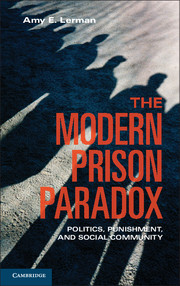Book contents
- Frontmatter
- Miscellaneous Frontmatter
- Contents
- Acknowledgments
- 1 The Modern Prison Paradox
- 2 Politics and the Punitive Turn
- 3 Public Policy and the Creation of Community
- 4 The Culture and Consequence of Prison
- 5 The Social Effects of Incarceration
- 6 The Social Effects of Prison Work
- 7 From Individuals to Communities
- 8 The Road to Reform
- 9 Epilogue (Or: How I Went to Berkeley and Wound Up in Prison)
- Appendixes
- Notes
- Index
7 - From Individuals to Communities
Published online by Cambridge University Press: 05 June 2014
- Frontmatter
- Miscellaneous Frontmatter
- Contents
- Acknowledgments
- 1 The Modern Prison Paradox
- 2 Politics and the Punitive Turn
- 3 Public Policy and the Creation of Community
- 4 The Culture and Consequence of Prison
- 5 The Social Effects of Incarceration
- 6 The Social Effects of Prison Work
- 7 From Individuals to Communities
- 8 The Road to Reform
- 9 Epilogue (Or: How I Went to Berkeley and Wound Up in Prison)
- Appendixes
- Notes
- Index
Summary
Your own safety is at stake when your neighbor’s wall is ablaze.
Horace, Epistles (20–c. 8 BC)In the preceding chapters, I have argued that the choices states make about institutions of punishment can play an important role in shaping how individuals perceive of and engage with one another. Specifically, I have shown that more violent and punitive correctional institutions create a disjointed form of social community; salient social ties are formed between some groups of individuals within these institutions, but such groups serve to bond rather than bridge. More important, these prison-based social groups foster attitudes among their members that discourage generalized trust and a broader sense of social connection. For inmates, social ties in a more violent and punitive prison can promote an aggressive response to resolving interpersonal conflict and may help to explain increased rates of recidivism. For correctional officers, social dynamics within the punitive prison may foster a wariness of others and a harsher orientation toward inmates, which can spill over to their personal lives.
The focus of these analyses has been the individual officer and inmate. However, I have suggested throughout the previous chapters that these individual-level effects may have wider consequences for American communities. In this chapter, I ask: To what types of communities do prisoners return?
- Type
- Chapter
- Information
- The Modern Prison ParadoxPolitics, Punishment, and Social Community, pp. 150 - 166Publisher: Cambridge University PressPrint publication year: 2013



